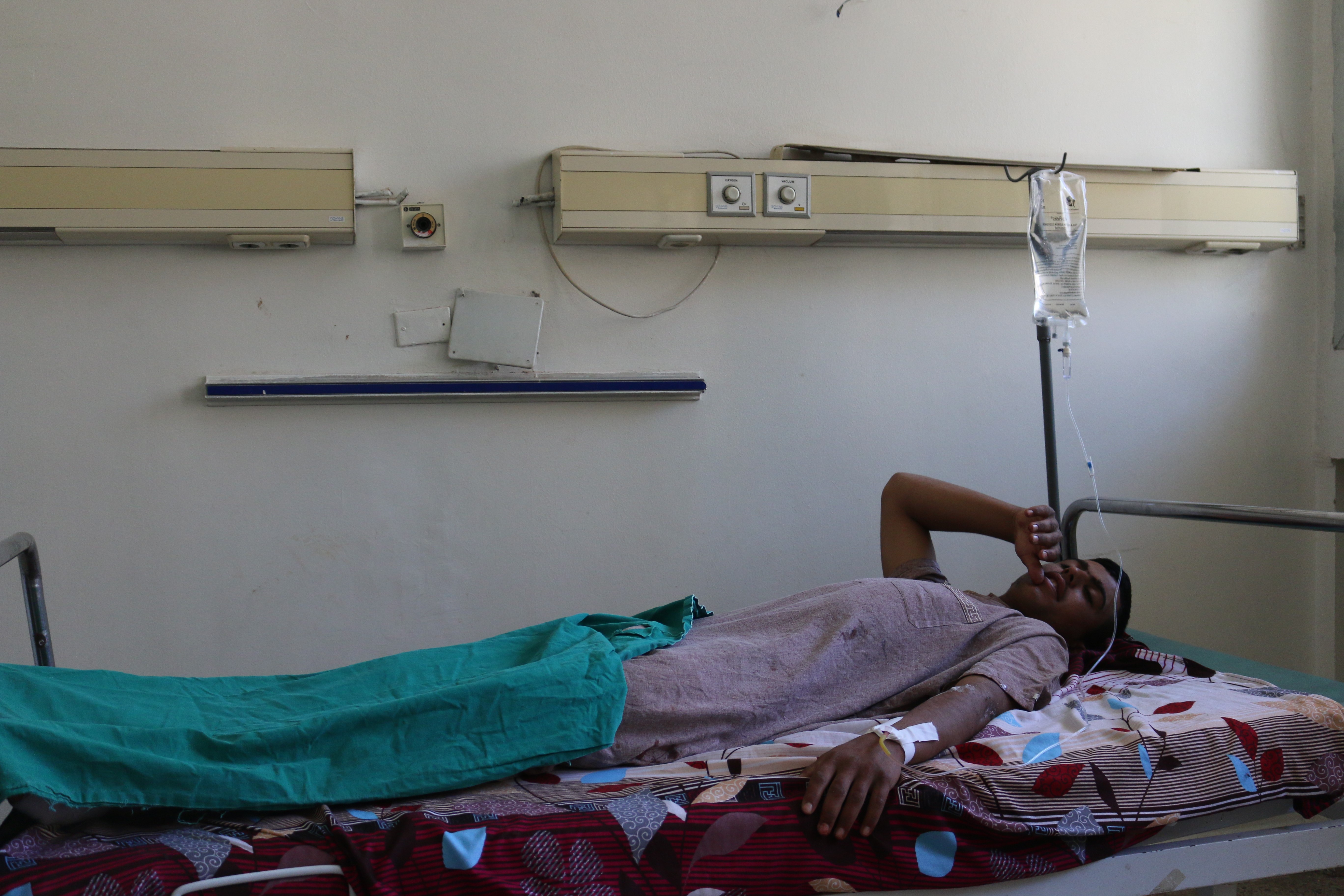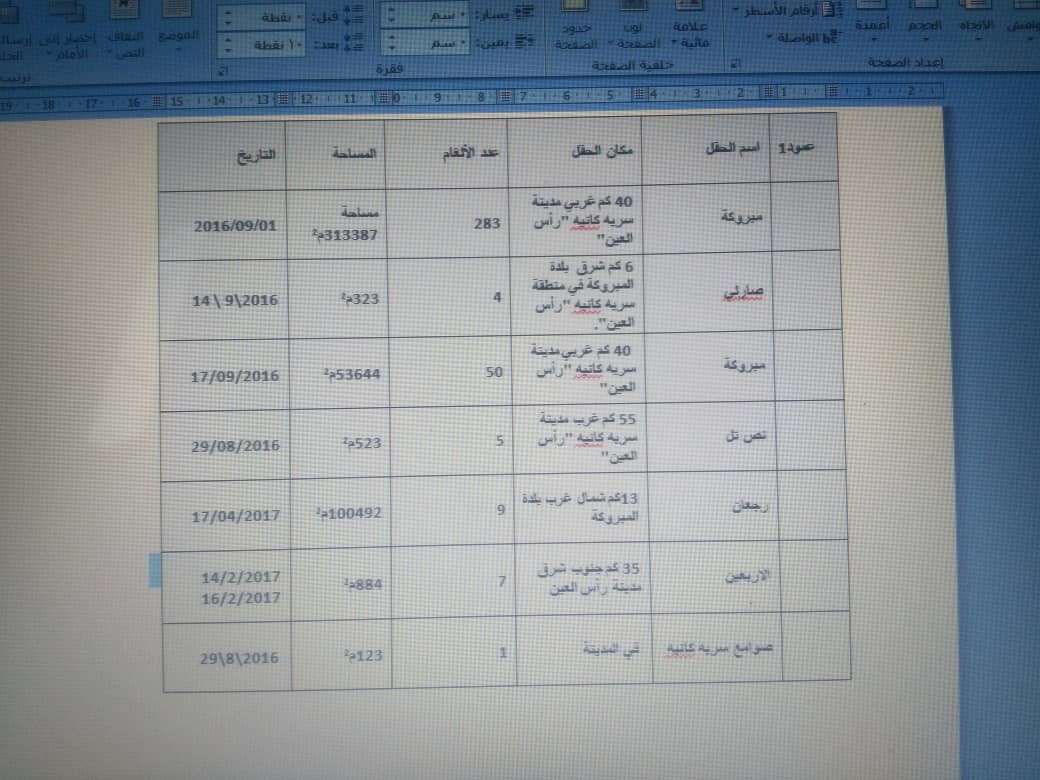Introduction Mines and explosive remnants of war (ERW) pose a pressing danger to civilians, especially the children. In June 2018, three children were injured with wounds of varying degrees following the detonation of several explosive remnants of war (ERW) in the Autonomous Administration-controlled Ras al-Ayn/Sari Kani city and its countryside[1]. On June 28, 2018, a 9-year-old kid was injured due to the explosion of a hand grenade near Ras al-Ayn/Sari Kani, preceded by another incident on June 19, 2018, when two other children were injured due to the explosion of a landmine on the outskirts of al-Rawiya town[2], located west of Ras al Ayn/Sari Kani.
According to the field researcher of STJ, not only June 2018 witnessed the injury of children and the killing of civilians by explosion of ERWs, especially those planted by ISIS. Late April 2018, a 13-year-old child recorded to be affected with serious wounds due to detonation of an explosive remnant of war (ERW) in Jabal Abd al-Aziz south of al-Hasakah city. Moreover, on May 12, 2018, four civilians were recorded killed as a result of explosion of a mine in Raqqa[3] city.
ISIS along with some fighters who remained from al-Nusra Front and other factions had planted thousands of mines in the west countryside of Sari Kani before they withdrew pose violent battles against YPG. At the time, they withdrew to Tell Halaf town, 5 kilometers west of Sari Kani in mid-2013, the STJ's filed researcher said.
Previously, on May 2, 2018, three children had been killed and six others injured because a residue of ISIS organization exploded in al-Jisr al-Abyad area located west of al-Hasakah city. STJ had prepared a flash report on the incident, in addition to another report in late 2017 regarding the killing of 12 civilians and the injury of 27 others following the explosion of two landmines planted on the administrative border between both provinces al-Hasakeh and Deir az-Zor, while a group of displaced people fleeing ISIS-held areas in Deir az-Zor were passing to the Autonomous Administration-control zones in al-Hasakah province.
Three Kids Wounded in Ras al-Ayn/Sari Kani and Its Countryside
On June 28, 2018, a child was wounded near Ras al-Ayn/Sari Kani, after a hand grenade from ISIS residues exploded. An ERW blew up while the child Mohamed Hussein ar-Rajab, 9, who hails from Raqqa, was grazing the cattle on the banks of the Khabur River, south of the city, which affected him with shrapnel in his left leg and his right knee. However, he recovered after receiving treatment in Roj Hospital located in Ras al-Ayn/Sari Kani, STJ's field researcher said.
Earlier, on June 19, 2018, two other children were injured with wounds of varying degrees after a landmine from ISIS's residues exploded in the surroundings of al-Rawiya town, west of the city. In this regard, Salah Ali Zaher, 17, one of the child victims who were affected in that explosion, narrated to STJ,
"Around 5:00 am, I went out along with my cousin Ammar Zaher, 17 years old, to graze the sheep in an agricultural land that had been harvested. We were wandering in the land while the sheep were grazing until 7:30 a.m. when the incident occurred. A landmine blew up and we fell down on the ground; we fainted for a moment, and then I saw my cousin stained with blood; I was unable to move from the intensity of the pain, but I pulled myself together, picked up my cellphone that was intact because it was in my pocket, and I called my father and asked for help. Soon, in less than ten minutes, my father, my uncle and his sons, and the village's young men came to transport us to Roj Hospital located in Ras al Ayn/Sari Kani."

An image showing Salah Zaher, one of the children victims affected following the explosion of a landmine from ISIS remnants in Ras al-Ayn/ Sari Kani, taken June 2018.
Photo credit: STJ
In another testimony came by Dilawar Mohammed Ali, a nurse at Roj Hospital located in Ras al Ayn/Sari Kani, told STJ that one of the two injured children identified as Ammar Zaher had been dispatched to the hospitals in Qamishli city due to his serious injuries. He added,
"At 8:30 a.m. on Tuesday, June 19, 2018, we received the two wounded children, and after giving them first aid, we found that the child Salah Ali Zaher was injured by shrapnel only in the side of his abdomen and feet and his health condition was stable, so he underwent treatment at the hospital, But for his cousin Ammar Zaher, he had serious wounds since he had suffered many shrapnel in his head, eyes, hands and feet, in addition to other injuries, so we transported him to the hospitals in Qamishli city to undergo a surgical operation and complete his treatment."
On April 25, 2018, another child was seriously injured, following the explosion of a landmine from ISIS residues near Jrn village located in Jabal Abd al-Aziz south of al-Hasakah city. The mine left behind by ISIS organization detonated when the 13-year-old child Maher al-Hassan stepped on it while grazing the sheep near the village. Maher was taken to Roj Hospital in Sari Kani for treatment. But the serious injuries inflicting on him prompted his transfer to the hospitals in Qamishli city to complete the treatment, the nurse Dilawar Mohammad Ali stated.
Dilawar added,
"On Wednesday, April 25, 2018, we received the injured child about two hours after the explosion i.e. at 2:00 pm. He was affected with shrapnel in different parts of his body, and the medical staff rushed to give him first aid and bandage his wounds, But because of the many shrapnel in his body, he needed an immediate surgical operation. Therefore, about an hour after his arrival, we transferred him to the hospitals in Qamishli to complete the treatment."
On May 12, 2018, four persons were killed as a result of a landmine explosion from ISIS remnants in Raqqa city; the explosion took place when a machine was removing debris from a ruined building in the Amasi neighborhood located in the center of Raqqa city, which resulted in the death of four workers who were doing renovations in the building, according to the field researcher of STJ.
The Process of Demining Northeast Syria
According to a statistic obtained by STJ's field researcher from Roj Mine Control Organization (RMCO)[4], it said from August 29, 2016 to April 17, 2017, the organization had removed and demined 359 mines from the residue of ISIS in an area of more than 469,000 m2, specifically in Ras Al Ain/Sari Kani and its western countryside to Mabrouka town. According to the field researcher the mines and explosive remnants of war (ERW) have left many victims being dead or wounded in the western countryside of Sari Kani early 2013, but there are no official statistics documenting the number of victims.

An image showing the number of mines removed from Ras al-Ayn/Sari Kani and its western countryside by Roj Mine Control Organization (RMCO) between 2016 and 2017, taken in June 2018 from the archive of RMCO.
Photo credit: STJ
The Roj Mine Control Organization is active in all areas north of Syria (Rojava), with greater attention being given to the more dangerous areas that are close to human populations. Alan Osman, the vice-president of the organization, confirmed this and spoke to STJ in this regard:
"Since the establishment of RMCO, we have been working voluntarily with limited potentials in addition to little and unsophisticated equipment to protect civilians' lives from the hazard of mines and explosive remnants of war (ERW) that the Islamic State (ISIS) had left behind in all the northern areas of Syria. With the beginning of 2018, our work was concentrated in Raqqa and its countryside due to the large numbers of mines planted by ISIS, and the increase number of victims that was recorded almost every day. We have removed many mines from water stations, power stations and irrigation canals, and we have opened many booby-trapped roads, in addition to clearing vast areas planted with mines and ERWs. This helped to get back to normal life in many neighborhoods of Raqqa and the villages in the northern countryside, let alone the decline in the number of victims."
Fawaz Mohamed, chief of the awareness section at RMCO spoke to STJ that the organization is seeking to minimize the ratio of victims of mines and ERWs through educating the local communities in the conflict-affected areas on mines and ERWs danger, and instruct them on how to deal with them. In this regard, he said,
"We conduct awareness sessions for the villagers and locals of the conflict-affected areas, in addition to distributing brochures aiming to promote the individuals' safe behaviour in dealing with the hazard of mines and ERWs, which requires not to touch or approach them, and to immediately report the competent authorities. The implementation of such a behaviour will effectively minimize the number of civilian casualties that caused by the detonation of these mines. Our main purpose is to convey the message to everyone. Moreover, I would like to I say an important thing, that the impact of explosive remnants of war (ERW), being missiles or mines, lasts for tens of years. Therefore, we are trying to cover as many people as we can to educate them on the danger and damage of mines, specifically the children since they are spontaneous in their actions and do not realize the real meaning of danger; they touch or play with any strange object they observe. Hence, we use special boards with cartoon graphics to educate them of the danger of mines and ERWs."
[1] On November 9, 2012, some battalions of the Syrian armed opposition and al-Nusra Front took over Ras al-Ayn/Sari Kani city and its countryside. Later, in the first half of 2013, People's Protection Units (YPG) managed to oust the armed opposition forces from the city after several sporadic battles. However, militants of al-Nusra Front remained there, but the YPG could expel them as well after three days of fighting. At the time, the militants of al-Nusra Front pledged allegiance to Abu Bakr al-Baghdadi, leader of the Islamic States (ISIS).
[2] On May 29, 2015, the People's protection Units (YPG) expelled ISIS troops from al-Rawiya village located in the western countryside of Ras al-Ayn/Sari Kani, in the context of the second stage of the military campaign launched on May 27, 2015 southwest of the city by YPG. ISIS had taken over the village on June 5, 2014, after fights with the YPG.
[3] On October 20, 2017, the Syrian Democratic Forces (SDF) could control Raqqa and oust ISIS troops.

